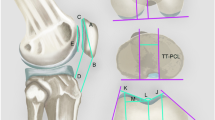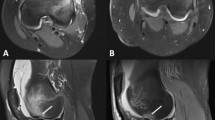Abstract
Purpose
Patellofemoral osteoarthritis (PFOA) occurs in approximately half of anterior cruciate ligament (ACL)-injured knees within 10–15 years of trauma. Risk factors for post-traumatic PFOA are poorly understood. Patellofemoral alignment and trochlear morphology may be associated with PFOA following ACL reconstruction (ACLR), and understanding these relationships, particularly early in the post-surgical time period, may guide effective early intervention strategies. In this study, patellofemoral alignment and trochlear morphology were investigated in relation to radiographic features of early PFOA 1-year post-ACLR.
Methods
Participants (aged 18–50 years) had undergone ACLR approximately 1 year prior to being assessed. Early PFOA was defined as presence of a definite patellofemoral osteophyte on lateral or skyline radiograph. Sagittal and axial plane alignment and trochlear morphology were estimated using MRI. Using logistic regression, the relationship between alignment or morphology and presence of osteophytes was evaluated.
Results
Of 111 participants [age 30 ± 8.5; 41 (37%) women], 19 (17%) had definite osteophytes, only two of whom had had patellofemoral chondral lesions noted intra-operatively. One measure of patellar alignment (bisect offset OR 1.1 [95% confidence interval 1.0, 1.2]) and two measures of trochlear morphology (sulcus angle OR 1.1 [1.0, 1.2], trochlear angle OR 1.2 [1.0, 1.5]) were associated with patellofemoral osteophytes.
Conclusions
Patellofemoral malalignment and/or altered trochlear morphology were associated with PFOA 1 year following ACLR compared to individuals post-ACLR without these features. Clarifying the role of alignment and morphology in post-traumatic PFOA may contribute to improving early intervention strategies aimed at secondary prevention.
Level of evidence
IV.



Similar content being viewed by others
Abbreviations
- 3D VISTA:
-
Three-dimensional volume isotropic turbo spin echo acquisition
- ACL:
-
Anterior cruciate ligament
- ACLR:
-
Anterior cruciate ligament reconstruction
- ANOVA:
-
Analysis of variance
- BMI:
-
Body mass index
- CI:
-
Confidence interval
- ICC:
-
Intra-class correlation coefficients
- MRI:
-
Magnetic resonance imaging
- OA:
-
Osteoarthritis
- OR:
-
Odds ratio
- PF:
-
Patellofemoral
- SEM:
-
Standard error of measure
References
Ali SA, Helmer R, Terk MR (2010) Analysis of the patellofemoral region on MRI: association of abnormal trochlear morphology with severe cartilage defects. AJR Am J Roentgenol 194(3):721–727
Botchu R, Obaid H, Rennie WJ (2013) Correlation between trochlear dysplasia and anterior cruciate ligament injury. J Orthop Surg 21(2):185–188
Callaghan M, Guney H, Reeves N, Bailey D, Doslikova K, Maganaris C, Hodgson R, Felson D (2016) A knee brace alters patella position in patellofemoral osteoarthritis: a study using weight bearing magnetic resonance imaging. Osteoarthr Cartil 24(12):2055–2060
Cameron ML, Briggs KK, Steadman JR (2003) Reproducibility and reliability of the outerbridge classification for grading chondral lesions of the knee arthroscopically. Am J Sports Med 31(1):83–86
Crossley K, Marino G, Macilquham M, Schache A, Hinman R (2009) Can patellar tape reduce the patellar malalignment and pain associated with patellofemoral osteoarthritis? Arthritis Rheumatol 61(12):1719–1725
Crossley KM, Vicenzino B, Lentzos J, Schache AG, Pandy MG, Ozturk H, Hinman RS (2015) Exercise, education, manual-therapy and taping compared to education for patellofemoral osteoarthritis: a blinded, randomised clinical trial. Osteoarthr Cartil 23(9):1457–1464
Culvenor AG, Collins NJ, Guermazi A, Cook JL, Vicenzino B, Khan KM, Beck N, van Leeuwen J, Crossley KM (2015) Early knee osteoarthritis is evident one year following anterior cruciate ligament reconstruction: a magnetic resonance imaging evaluation. Arthritis Rheumatol 67(4):946–955
Culvenor AG, Cook JL, Collins NJ, Crossley KM (2013) Is patellofemoral joint osteoarthritis an under-recognised outcome of anterior cruciate ligament reconstruction? A narrative literature review. Br J Sports Med 47(2):66–70
Culvenor AG, Engen CN, Øiestad BE, Engebretsen L, Risberg MA (2015) Defining the presence of radiographic knee osteoarthritis: a comparison between the Kellgren and Lawrence system and OARSI atlas criteria. Knee Surg Sports Traumatol Arthrosc 23(12):3532–3539
Culvenor AG, Lai CC, Gabbe BJ, Makdissi M, Collins NJ, Vicenzino B, Morris HG, Crossley KM (2014) Patellofemoral osteoarthritis is prevalent and associated with worse symptoms and function after hamstring tendon autograft ACL reconstruction. Br J Sports Med 48(6):435–439
Culvenor AG, Schache AG, Vicenzino B, Pandy MG, Collins NJ, Cook JL, Crossley KM (2014) Are knee biomechanics different in those with and without patellofemoral osteoarthritis after anterior cruciate ligament reconstruction? Arthritis Care Res Hoboken 66(10):1566–1570
Felson DT, Niu J, Guermazi A, Sack B, Aliabadi P (2011) Defining radiographic incidence and progression of knee osteoarthritis: suggested modifications of the Kellgren and Lawrence scale. Ann Rheum Dis 70(11):1884–1886
Filbay SR, Ackerman IN, Russell TG, Macri EM, Crossley KM (2014) Health-related quality of life after anterior cruciate ligament reconstruction: a systematic review. Am J Sports Med 42(5):1247–1255
Friel NA, Chu CR (2013) The role of ACL injury in the development of posttraumatic knee osteoarthritis. Clin Sports Med 32(1):1–12
Hart HF, Culvenor AG, Collins NJ, Ackland DC, Cowan SM, Machotka Z, Crossley KM (2016) Knee kinematics and joint moments during gait following anterior cruciate ligament reconstruction: a systematic review and meta-analysis. Br J Sports Med 50:597–612
Hoffelner T, Resch H, Moroder P, Atzwanger J, Wiplinger M, Hitzl W, Tauber M (2012) No increased occurrence of osteoarthritis after anterior cruciate ligament reconstruction after isolated anterior cruciate ligament injury in athletes. Arthroscopy 28(4):517–525
Insall J, Salvati E (1971) Patella position in the normal knee joint 1. Radiology 101(1):101–104
Iwano T, Kurosawa H, Tokuyama H, Hoshikawa Y (1990) Roentgenographic and clinical findings of patellofemoral osteoarthrosis. With special reference to its relationship to femorotibial osteoarthrosis and etiologic factors. Clin Orthop Relat Res 252:190–197
Jarvela T, Paakkala T, Kannus P, Jarvinen M (2001) The incidence of patellofemoral osteoarthritis and associated findings 7 years after anterior cruciate ligament reconstruction with a bone-patellar tendon-bone autograft. Am J Sports Med 29(1):18–24
Kellgren JH, Lawrence JS (1957) Radiological assessment of osteo-arthrosis. Ann Rheum Dis 16(4):494–502
Losina E, Weinstein AM, Reichmann WM, Burbine SA, Solomon DH, Daigle ME, Rome BN, Chen SP, Hunter DJ, Suter LG (2013) Lifetime risk and age at diagnosis of symptomatic knee osteoarthritis in the US. Arthritis Care Res Hoboken 65(5):703–711
Macri E, Stefanik J, Khan K, Crossley K (2016) Is tibiofemoral or patellofemoral alignment or trochlear morphology associated with patellofemoral osteoarthritis? A systematic review. Arthritis Care Res Hoboken 68(10):1453–1470
Muellner T, Kaltenbrunner W, Nikolic A, Mittlboeck M, Schabus R, Vecsei V (1999) Anterior cruciate ligament reconstruction alters the patellar alignment. Arthroscopy 15(2):165–168
Neuman P, Englund M, Kostogiannis I, Fridén T, Roos H, Dahlberg LE (2008) Prevalence of tibiofemoral osteoarthritis 15 years after nonoperative treatment of anterior cruciate ligament injury a prospective cohort study. Am J Sport Med 36(9):1717–1725
Neuman P, Kostogiannis I, Friden T, Roos H, Dahlberg LE, Englund M (2009) Patellofemoral osteoarthritis 15 years after anterior cruciate ligament injury—a prospective cohort study. Osteoarthr Cartil 17(3):284–290
Ntagiopoulos PG, Bonin N, Sonnery-Cottet B, Badet R, Dejour D (2014) The incidence of trochlear dysplasia in anterior cruciate ligament tears. Int Orthop 38(6):1269–1275
Øiestad BE, Holm I, Engebretsen L, Risberg MA (2011) The association between radiographic knee osteoarthritis and knee symptoms, function and quality of life 10–15 years after anterior cruciate ligament reconstruction. Br J Sport Med 45(7):583–588
Papannagari R, Gill TJ, Defrate LE, Moses JM, Petruska AJ, Li G (2006) In vivo kinematics of the knee after anterior cruciate ligament reconstruction: a clinical and functional evaluation. Am J Sport Med 34(12):2006–2012
Pollard TC, Gwilym SE, Carr AJ (2008) The assessment of early osteoarthritis. J Bone Jt Surg Br 90(4):411–421
Powers CM, Shellock FG, Beering TV, Garrido DE, Goldbach RM, Molnar T (1999) Effect of bracing on patellar kinematics in patients with patellofemoral joint pain. Med Sci Sports Exerc 31(12):1714–1720
Risberg MA, Oiestad BE, Gunderson R, Aune AK, Engebretsen L, Culvenor A, Holm I (2016) Changes in knee osteoarthritis, symptoms, and function after anterior cruciate ligament reconstruction: a 20-year prospective follow-up study. Am J Sport Med 44(5):1215–1224
Salsich GB, Perman WH (2013) Tibiofemoral and patellofemoral mechanics are altered at small knee flexion angles in people with patellofemoral pain. J Sci Med Sport 16(1):13–17
Shabshin N, Schweitzer ME, Morrison WB, Parker L (2004) MRI criteria for patella alta and baja. Skeletal Radiol 33(8):445–450
Stefanik JJ, Roemer FW, Zumwalt AC, Zhu Y, Gross KD, Lynch JA, Frey-Law LA, Lewis CE, Guermazi A, Powers CM (2012) Association between measures of trochlear morphology and structural features of patellofemoral joint osteoarthritis on MRI: the MOST study. J Orthop Res 30(1):1–8
Stefanik JJ, Zumwalt AC, Segal NA, Lynch JA, Powers CM (2013) Association between measures of patella height, morphologic features of the trochlea, and patellofemoral joint alignment: the MOST study. Clin Orthop Relat Res 471(8):2641–2648
Tsavalas N, Katonis P, Karantanas AH (2012) Knee joint anterior malalignment and patellofemoral osteoarthritis: an MRI study. Eur Radiol 22(2):418–428
Van de Velde SK, Gill TJ, DeFrate LE, Papannagari R, Li G (2008) The effect of anterior cruciate ligament deficiency and reconstruction on the patellofemoral joint. Am J Sports Med 36(6):1150–1159
van der Heijden RA, de Kanter JL, Bierma-Zeinstra SM, Verhaar JA, van Veldhoven PL, Krestin GP, Oei EH, van Middelkoop M (2016) Structural abnormalities on magnetic resonance imaging in patients with patellofemoral pain a cross-sectional case-control study. Am J Sport Med: 44(9):2339-2346
Ward SR, Terk MR, Powers CM (2007) Patella alta: association with patellofemoral alignment and changes in contact area during weight-bearing. J Bone Jt Surg Am 89(8):1749–1755
Wong YM, Chan ST, Tang KW, Ng GY (2009) Two modes of weight training programs and patellar stabilization. J Athlet Train 44(3):264–271
Acknowledgements
We gratefully acknowledge support for this work, including funding from the Queensland Orthopaedic Physiotherapy Network, a University of Melbourne Research Collaboration grant and a University of British Columbia research grant. E. Macri received funding support from the Australian Endeavour Award Research Fellowship and Vanier Canada Graduate Scholarship (CIHR). A. Culvenor received funding from the European Union Seventh Framework Programme (Grant Agreement Number 607510).
Authors’ contributions
EM, KC, AG and KK formulated the research question with input from HM and TW. KC, AG, HM, TW developed the original study design, and EM, KC, AG, TR and KK developed the secondary study design. HM and TW completed all surgeries. AG completed data collection. TR developed software program for analysing alignment and morphology and trained EM in software use. KC and AG evaluated X-rays for OA findings. EM and KC developed protocol for analysing alignment and morphology. EM completed alignment and morphology measures. EM did statistical analysis with intellectual input from KC, AG, KK. EM led manuscript writing with intellectual input from all authors. All authors read and approved the final manuscript.
Author information
Authors and Affiliations
Corresponding author
Ethics declarations
Conflict of interest
The authors declare that they have no conflict of interest.
Funding
This work was supported by the Queensland Orthopaedic Physiotherapy Network, a University of Melbourne Research Collaboration grant and a University of British Columbia research grant. E. Macri received funding support from the Australian Endeavour Award Research Fellowship and Vanier Canada Graduate Scholarship (CIHR). A. Culvenor received funding from the European Union Seventh Framework Programme (Grant Agreement Number 607510). Dr. Whitehead reports personal fees from a Smith and Nephew Clinical Fellowship and personal fees from Smith and Nephew speaking engagement, outside the submitted work. Dr. Morris reports personal fees from Oceania Orthopaedics Clinical Fellowship, outside the submitted work.
Ethical approval
This study was approved by the appropriate ethics committees (The University of Melbourne, ID 1136167, and The University of Queensland, IDs 2012000567 and 2013001448) and have been performed in accordance with the ethical standards laid down in the 1964 Declaration of Helsinki.
Informed consent
Participants provided written informed consent prior to participation.
Rights and permissions
About this article
Cite this article
Macri, E.M., Culvenor, A.G., Morris, H.G. et al. Lateral displacement, sulcus angle and trochlear angle are associated with early patellofemoral osteoarthritis following anterior cruciate ligament reconstruction. Knee Surg Sports Traumatol Arthrosc 26, 2622–2629 (2018). https://doi.org/10.1007/s00167-017-4571-1
Received:
Accepted:
Published:
Issue Date:
DOI: https://doi.org/10.1007/s00167-017-4571-1




